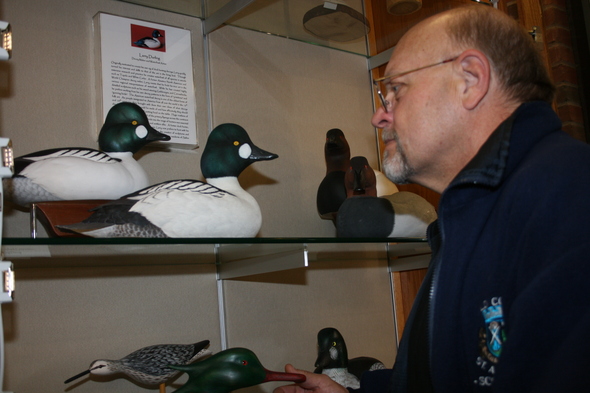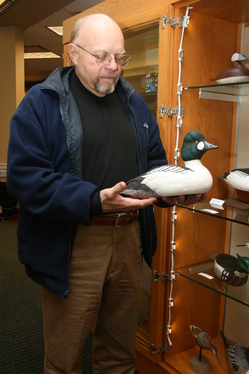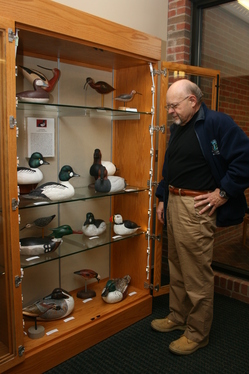Saline Township artist brings keen eye, steady hand to carved duck decoys

Larry Darling of Saline Township is displaying some of his duck decoys at the Saline District Library through May.
Lisa Allmendinger | Ann Arbor.com
Larry Darling of Saline Township has a serious thing for ducks.
The retired preservation engineer and former duck hunter has combined his interest in historic preservation and one of the oldest forms of folk art into an unusual hobby — he’s a decoy maker and waterfowl artist.
“For me, it’s the sustainability of a true folk art. These put food on the table for the early pioneers,” he says, talking about the decoys.
Visitors can see 16 of his pieces at the Saline District Library in a display case at the front of the library through May.
Decoys are used to lure waterfowl into an area for hunting. Darling says he grew up on a farm and even as a child, he was an avid duck hunter. For years, he says, he wanted to learn to create decoys and about 20 years ago, a friend invited him to take a class.

Larry Darling shows off one of his favorite duck decoys.
Lisa Allmendinger | AnnArbor.com
At one time, decoy making was a major industry in the Mid-Atlantic and then later in the Great Lakes region. Before that, Native American crafted them.
“The American waterfowl decoy is one of the oldest forms of folk art,” he says.
Since taking those classes, Darling has become quite talented in the folk art form. His tournament resume is proof: It includes both the Amateur North American and World Champion Decoy Maker titles. At last count, Darling says, he’s made between 400 to 500 duck decoys. It takes about 2,000 hours to make a detailed sculpture, while birds he makes for tournaments take 150 to 200 hours each.
However, his favorites, the primitives, take less time. Darling says he can knock out five in a week if he gets on a roll.

Larry Darling has about 16 duck decoys on display at the Saline District Library.
Lisa Allmendinger | AnnArbor.com
Many of his decoys are made from Tupelo wood that comes from Louisiana.
“There’s no grain. It’s like carving butter,” he says.
Others are made from white cedar, and he’s even made a few from canvas. Regardless of whether he’s making a sculpture that replicates the real duck species in every aspect or “gunners” the traditional decoy that are weighted for proper flotation in the water, or his favorite primitives, it’s all about "form and finish."
One of the toughest aspects is crafting a proper duck head. It must sit naturally on the neck, be the right size and have a correctly shaped bill and eye set.
“You want the decoy to look relaxed and almost sleeping,” he says, so the real ducks will fly in to investigate.
Goldeneyes, a sea duck, and canvasbacks, a diving duck, are his two favorites.
Darling says because of his affiliation with the artists at Two Twelve Arts Center in Saline, he’s branching out into watercolor and ink ducks as well.
And yes, he does sell his pieces. The primitives range in price from $100 to $200 while the shore birds called “stick-ups” are $35 to $100. The tournament birds are between $400 to $500, and more elaborate sculptures range from $6,000 to $8,000.
Today, Darling says, he hunts with his camera — shooting reference photos for his decoys.
Lisa Allmendinger is a reporter with AnnArbor.com. She can be reached at lisaallmendinger@annarbor.com. For more Saline stories, visit our Saline page.


Comments
Jim Nazium
Mon, May 2, 2011 : 12:56 a.m.
Nice work Larry, it's great to see you get some recognition for your fine talent. Keep up the good work.
Tom Joad
Sun, May 1, 2011 : 8:37 p.m.
You had me until the crass prices reared up...